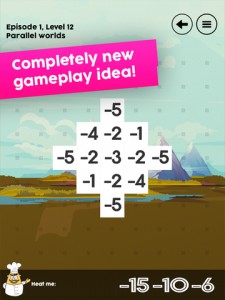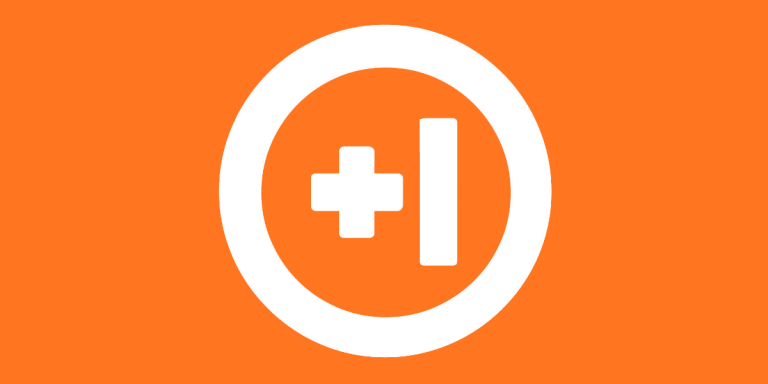Right about now it’s probably time to start asking yourself if you happen to like tricky math problems that are positively guaranteed to drive you up the wall in utter frustration. If you answered that question with yes — or at the very least are still cautiously optimistic — then you might just be interested in Number Chef (out now, free), the newest offering from Roope Rainisto. For each level you’ll be given a non-randomized grid-like field of tiles, and you’ll then be challenged by the chef to create a series of very specific numbers using some deceptively simple-looking rules.
 You control the game by grabbing a tile with your finger and then dragging it towards its adjacent neighbor in any of the four cardinal directions, which results in that tile being permanently combined with the one you dropped it on. Afterwards the entire playing field will restructure itself — if necessary — in order to ensure that every last tile is always connected to something, and then you’ll keep repeating the process until you ideally win. Although Number Chef’s controls might initially seem simple enough, at least when they work correctly (a problem which I’ll tackle further down), it’s the way in which the chef’s tiles combine that’s guaranteed to drive you positively bonkers.
You control the game by grabbing a tile with your finger and then dragging it towards its adjacent neighbor in any of the four cardinal directions, which results in that tile being permanently combined with the one you dropped it on. Afterwards the entire playing field will restructure itself — if necessary — in order to ensure that every last tile is always connected to something, and then you’ll keep repeating the process until you ideally win. Although Number Chef’s controls might initially seem simple enough, at least when they work correctly (a problem which I’ll tackle further down), it’s the way in which the chef’s tiles combine that’s guaranteed to drive you positively bonkers.
Whenever you drag a normal numbered onto a similarly normal tile sporting an even number, that even number will then be subtracted from the value of the tile you just moved over. Meanwhile — however — if you move a standard title onto another non-special tile featuring an odd number, then the resulting combination will be one wherein the two tiles have been added together. As a result, you can — even when using the exact same two tiles — get two radically different results based upon which tile you physically pick up (especially when only one of them is oddly numbered).
To ensure this all makes sense, here are some sample cases:
– Dragging a 3 over to a 5 equals 8, this is also true for dragging a 5 over to a 3 as well.
– Now whereas sliding a 4 over to a 3 equals 7, sliding a 3 over to a 4 is actually -1.
– Moving a 4 over to an 8 results in a -4, yet moving an 8 over to a 4 yields another 4.
– Putting a 1 on top of a -4 will create a 5, yet putting -4 on top of a 1 makes -3 instead.
 Or at least that’s how everything works inside Number Chef’s first episode, which contains a total of fifteen different stages — all playable in any order you choose — featuring only these rules. In total there are eight different major episodes available, each of which adds a new rule to the layered mix (and will furthermore contain another fifteen of the chef’s mind-bending non-randomized challenges). You initially begin with only Number Chef’s first episode unlocked (unless you use IAPs), with later episodes made available after twelve of the prior section’s fifteen stages have first been conquered.
Or at least that’s how everything works inside Number Chef’s first episode, which contains a total of fifteen different stages — all playable in any order you choose — featuring only these rules. In total there are eight different major episodes available, each of which adds a new rule to the layered mix (and will furthermore contain another fifteen of the chef’s mind-bending non-randomized challenges). You initially begin with only Number Chef’s first episode unlocked (unless you use IAPs), with later episodes made available after twelve of the prior section’s fifteen stages have first been conquered.
These later episodes — no matter how you reach them — will all include their new rule possibilities in the form of special tiles, many of which are immune to the normal even/odd rules. These include: multiply tiles (which multiply whatever you mix them with), polarity flipping tiles (that invert their +/- aspect after every turn), cloning tiles (that duplicate whatever you drop on them, without consuming the original), and more. Figuring out how to ideally use all of these rules — and which order to best combine the various tiles you’re given — will quickly beat down even the mightiest of mathematicians, for no one ever truly escapes the cruel-hearted chef’s mocking wrath.
The chief most reason I haven’t given Number Chef a solid four, despite the fact I appreciate the game’s challenge, would lie within the chef’s IAP system (but not the aforementioned option to immediately unlock episodes two through eight for just $0.99). My beef with this game is instead derived from Number Chef’s option to permanently unlock the “undo move” function for $0.99, with players otherwise being forced to restart a puzzle from scratch whenever they accidentally mess up. Now while this wouldn’t necessarily be the most unpardonable of sins for nearly any other game, the key dilemma here would be the potential implications one can draw regarding Number Chef’s controls.
 Basically put, during my time with Number Chef it quickly began to seem as though the controls — which would occasionally move tiles nowhere near where I was touching — had a mind entirely their own. While it’s entirely possible that what I experienced was merely a quirk of the smaller screened device I used (an iPod Touch 5, to be exact) the facts are — at least from my perspective — that Number Chef’s controls don’t function consistently. While this would certainly be somewhat annoying all on its own, here we have a puzzle game where the undo move function — something that would otherwise be standard access in virtually any other game ever produced — is instead being offered via IAPs.
Basically put, during my time with Number Chef it quickly began to seem as though the controls — which would occasionally move tiles nowhere near where I was touching — had a mind entirely their own. While it’s entirely possible that what I experienced was merely a quirk of the smaller screened device I used (an iPod Touch 5, to be exact) the facts are — at least from my perspective — that Number Chef’s controls don’t function consistently. While this would certainly be somewhat annoying all on its own, here we have a puzzle game where the undo move function — something that would otherwise be standard access in virtually any other game ever produced — is instead being offered via IAPs.
The flipside to all of this is that the problem can easily be fixed for a one-time purchase of just $0.99, which is admittedly far less money than most other free-based mobile games realistically demand of you. Yet with this admittedly cheap IAP option currently being used to fix a very real fault in Number Chef (since the dodgy controls will often lead you to unintentional failures), the game’s real price may as well actually be $0.99. The end result of all this is that I guess I would have felt less weird about the selfsame game if Number Chef had simply cost $0.99 up front, after which the faulty controls would have seemed far less dubious in nature.
However, whether the controls were faulty by design — or just accidentally happened to be that way — Number Chef is still one tough-as-nails game that fans of mathematical puzzles should greatly consider looking into (especially if the controls ever get fixed later on).
Verdict
Number Chef is an intriguing — yet tough-as-nails — game of deceptively simple seeming mathematical puzzles, where more and more rules are slowly added over time. Those whom both love math and being utterly stumped will greatly appreciate Number Chef’s 120 different non-randomized puzzles, what they might not necessarily love will be the game’s control issues. Currently the game has a nasty tendency of confusing which move you were trying to do, which is especially frustrating when the game’s “undo move” button has to be unlocked for a $0.99 cost.


